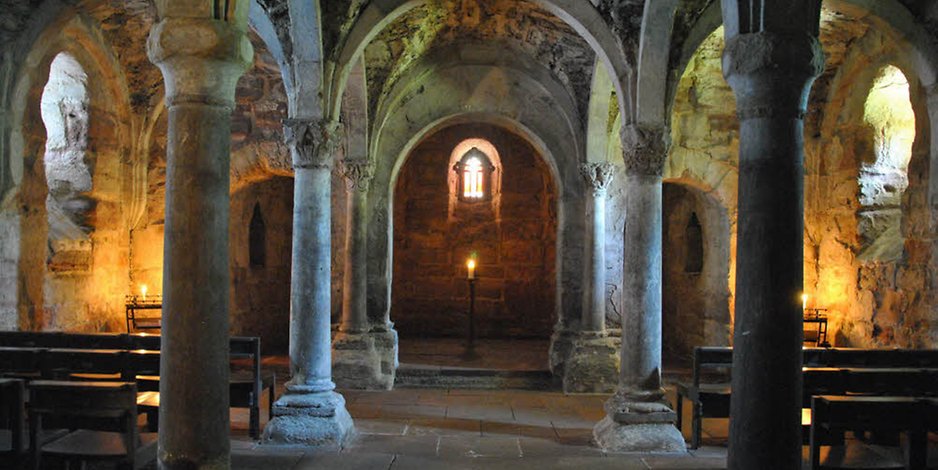Memleben, one of the royal centres in Ottonian Germany is located at the river Unstrut. Founded in the 8th century, its heyday fell in the late 10th century, when the last Ottonians briefly planned to turn the place into a memorial shrine for their dynasty

In the 10thcentury, the powerful centre of Europe tilted from France to Germany. Although the shift had already begun in the 9thcentury with the civil wars in the 840s and the later consolidation of the power base of Louis the German (c. 806 – 876), it was symptomatic that the short reunification of Western and Eastern Francia, which took place after the death of Louis, did not last. In the end, it petered out with the death of Louis the Child in 911. It was the chief councillors of this last Carolingian – the Archbishop of Mainz and the Bishop of Constance – who transferred the reins of power into the hands of the Frankish Conradines. At the death of Conrad the first, the power finally ended up in the hands of the Saxon Duke, Henry the Fowler, and with him the dynasty of the Ottonians.
Part of their heartland was Harz including the southeastern frontier region of the Saale-Unstrut. The settlement at Memleben was already mentioned at the end of the 8thcentury. However, it was not until the 10thcentury, the place gained in status and importance. Henry the Fowler (876 – 936) had a royal villa in Memleben. Here, he died in 936. Although his remains were interred at Quedlingburg, his son, Otto I continued to favour the place and at his approaching death in 973, he was once more drawn to the palace. According to Thietmar of Merseburg, his heart was buried at Memleben, while the rest of his remains were interred at Magdeburg.
Later, in 979, his son and successor, Otto II and his wife Theophanu, founded a Benedictine monastery near the royal palace. Endowed with huge tracts of land in Thuringia, Saxony, Hesse and Brandenburg it continued to grow when Otto III made plans to establish it as the centre of a bishopric. Regrettably, though, Memleben was located too close to the border and in 983 it lost most of its income and possessions due to a Slavic uprising.
Also, the last of the Ottonians, Henry II (973 – 1024) had other ideas. Soon the rights to hold markets, mint coin, and demand toll were abolished. The pet project of Henry II was the new bishopric in Bamberg, and as a consequence, the Abbey at Memleben was subordinated to the old Carolingian foundation, the ancient Abbey at Hersfeld. With these organisational changes, Memleben lost its status as the main memorial for the Ottonians. It is likely the great abbey church was never completed. The last German monarch to stay at Memleben was Conrad the II in 1033.
During the Reformation, peasants plundered the monastery and the revenues from the land were deeded to the Pforta School. After 1945, the remaining 3300 ha of land was appropriated by an agrarian commune, which was worked by more than 1200 farmers. Finally, after 1990, Memleben was renamed as Kloster und Kaiserpfalz Memleben vying for the position as the local tourist centre and gatekeeper of the Naturepark, Saale-Unstrut-Triaspark. Today, the Abbey is a museum
The Palace and the Monastery
Exactly where the Ottonian Palace was located is not known. Probably next to or beneath the Benedictine Monastery of which extensive ruins still stand; or it might be located at the ruins of the Wendelstein Castle.
The Ottonian memorial church measured c. 80 metres x 28 metres and had three naves, a double apse (one at each end), and possibly two crypts. It was apparently never finished. It is likely the crypts were intended as a double sanctuary, one for the sarcophagi of the kings and their family, with the adjoining one housing the celebration of the memorial masses and liturgical hours. The closest relative of the grand church in Memleben is the Cathedral in Cologne (version VII) c. 953 – 65.
The ruins next to the monastery belong to a church built to accommodate the community in the later Middle Ages.
VISIT:
Kloster und Kaiserpfalz Memleben
Thomas-Müntzer-Str. 48
D-06642 Memleben
Germany
Memleben is a point of interest listed on the Romanesque Route
READ MORE:
Memleben. Königspfalz, Reichskloster, Propstei
von Helge Wittmann
Vereins des Klosters und der Kaiserpfalz Memleben 2001 (2008)
SEE MORE:
Summer 2018, Memleben hosts a special exhibition focusing on Memleben as the Royal centre of the Ottonians.
Wissen & Macht
The post Memleben – a Royal and Monastic Centre in 10thcentury Germany appeared first on Medieval Histories.
Powered by WPeMatico